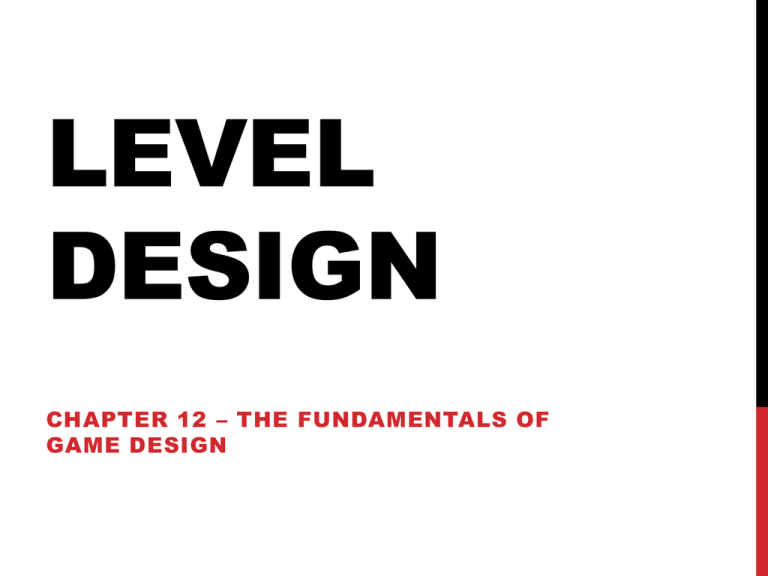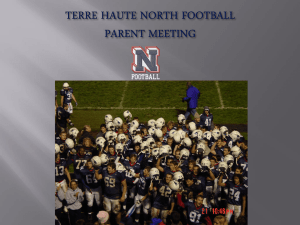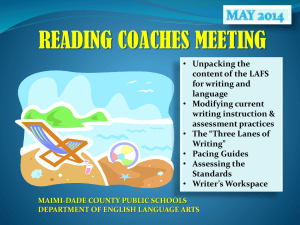slides
advertisement

LEVEL DESIGN CHAPTER 12 – THE FUNDAMENTALS OF GAME DESIGN WHAT IS LEVEL DESIGN? • Space in which a game takes place • Designed and using 2D or 3D modeling tools • Initial conditions of a level • Determines the initial state of variables in the level (drawbridge up or down, starting resources) • Set of challenges players faces in level • Enemies, puzzles, etc. WHAT IS LEVEL DESIGN? CONTINUED • Termination conditions of the level • What determines whether you win or lose in the level (defeating a boss for example) • Interplay between the gameplay and the story • Making sure that the story and gameplay work together coherently • Aesthetics and mood of the level • Tone and atmosphere created in the level (haunted house game) KEY DESIGN PRINCIPLES Universal Level Design Principles General guidelines every game should follow Genre Specific Design Principles Only apply to games in a specific genre UNIVERSAL LEVEL DESIGN PRINCIPLES • Include tutorial levels in the beginning • Vary pacing of the level • Provide resources upon completing challenges • Avoid conceptual non sequitirs • Everything should work and make sense together • Inform players of current goals in the level • Players should know what the next goal is not necessarily long term goals however UNIVERSAL LEVEL DESIGN PRINCIPLES • Reward players for skill, imagination, intelligence and dedication • Powerups, resources, shortcuts, etc. • Large rewards, small punishments • This will help not discourage players • Foreground takes precedence over background • Graphically focus on stuff right in front of the player first UNIVERSAL LEVEL DESIGN PRINCIPLES • AI in a game should put up fight but lose • Not extremely difficult to frustrate player • Multiple difficulty settings • This opens it up to a wider array of audiences GENRE-SPECIFIC LEVEL DESIGN PRINCIPLES • Design of levels is extremely dependent on which specific genre the game is catering to • Action • Pacing is crucial • Lots of high intensity areas followed by periods of recovery and rest (cutscenes) • Strategy games • Reward planning • Anticipating your opponents move and planning attacks or defense GENRE-SPECIFIC LEVEL DESIGN PRINCIPLES • Role Playing Games • Opportunities for character growth and selfexpression • Every level should have opportunities that reflect player’s persona in the game • Sports Games • Verisimilitude is vital • Each match can be considered a level • Design stadiums, players, jerseys GENRE-SPECIFIC LEVEL DESIGN PRINCIPLES • Vehicle Simulations • Reward skillful maneuvering • Steering is primary challenge, after that shooting and exploring etc. is secondary • Construction and Management Simulations • Offer an interesting variety of initial conditions and goals • Empty space where player has free reign • Scenarios where there is a goal to achieve in a specific time limit GENRE-SPECIFIC LEVEL DESIGN PRINCIPLES • Adventure Games • Construct challenges that harmonize with their locations and the story • Exploration and puzzle-solving • Each chapter is a new level, challenges should incorporate current environment • Artificial Life Games • Create many interaction opportunities for the creatures in their environment • Game designer typically specifies interaction opportunities GENRE-SPECIFIC LEVEL DESIGN PRINCIPLES • Puzzle Games • Give players time to think • Either create puzzles that give player complete freedom to think things through or allow pausing LEVEL LAYOUTS LEVEL LAYOUTS • Open • Linear • Parallel • Ring • Network • Hub-and-Spoke • Combinations OPEN LAYOUT • Almost entirely unconstrained movement • May have small regions that are only accessible in a linear fashion • Open map of an RPG • Eg. Skyrim main world LINEAR LAYOUT • Most common • Play may only go backwards or forwards • On rails • One-way doors sometimes that players can’t go back out of • Make sure to not lock out players if they haven’t obtained necessary item from region!! PARALLEL LAYOUT • Variant of linear • One fixed start and end point but variety of paths to get to the end • Players sometimes explore all paths • Some paths easier, some more difficult RING LAYOUT • Level returns to it’s original starting point • May be shortcuts in the level • Shortcuts faster but proportionately more difficult • Primarily in racing games NETWORK LAYOUTS • Spaces connect to each other • Learning way around is a challenge • Gives player freedom on what path to take • Difficult for story telling HUB-AND-SPOKE LAYOUTS • Central hub that implies safety • Linear path out of hub and then back • Return journey quick • Major challenge/reward at end of spoke • You can make certain spokes accessible at different times COMBINATION LAYOUTS • Combines several types • RPGS where main map but subplots or quests • Game is linear but levels can be completed in various orders PRINCIPLES OF LEVEL DESIGN PRINCIPLES OF LEVEL DESIGN • Atmosphere • Progression • Pacing • Tutorial Levels ATMOSPHERE • Lighting • Color Palette • Weather and Atmospheric Effects • Special Visual Effects • Music • Ambient Audio • Special Audio Effects ATMOSPHERE LIGHTING • Placement and orientations of the lights set the scene • Lights have to fit area and the mood of the level • Sunlight for warm and cheery • Moonlight for a dark alley • What you don’t light is just as important as what as lit ATMOSPHERE LIGHTING https://lh3.googleusercontent.com/MgKHubmf9ds/Tr5eXeS3eKI/AAAAAAAAFn0/xI0yZuEV1Dk/s6 00/gt5time4darkxuoi.gif http://www.abload.de/img/gt5timesuwd.gif ATMOSPHERE – COLOR PALETTE • Colors of a level reflect its mood • Combination of colors on the objects as well as the lighting • They can elicit specific emotions from players ATMOSPHERE – WEATHER • Fog, rain, snow and wind all create distinct impressions • Dark skies show storm • Fog creates mystery • Wind suggests instability ATMOSPHERE – SPECIAL VISUAL EFFECTS • Weapon recoil, tires screeching creating smoke, magic spells • Startle players • Discomfort them • Amuse them • Reward them ATMOSPHERE – MUSIC • Rhythm of the music can set the pace of the game or the current level • Keep with the tone of the game • Generally remains consistent throughout the level ATMOSPHERE – MUSIC • http://www.youtube.com/watch?v=C RwWGXEsxm4 ATMOSPHERE – AMBIENT AUDIO • Contributes to overall mood of the level • May vary with place and time in the level • Can help player orient themselves • Night time, enemies near, market square ATMOSPHERE – AMBIENT AUDIO • http://www.youtube.com/watch?v=u 1nY_5-UrY4 ATMOSPHERE – SPECIAL AUDIO EFFECTS • Help alert the players of what they might not observe visually • http://www.youtube.com/watch?v= OSg_c9uWg0U PROGRESSION AND PACING • Games that are over an hour in length should have some form of progression system • Having challenges that too close together can create stress for the player PROGRESSION • Mechanics • Experience duration • Ancillary awards and environmental progression • Practical gameplay rewards • Difficulty • Actions available to the player • Story progression • Character growth PACING • Designing the pacing • First you must decide the genre that is being designed for • Varying the pacing • Should vary, fast sections followed by slow sections • Overall pacing • Pacing should increase throughout the game and climax with the final boss battle TUTORIAL LEVELS • Used to be game manuals, now tutorial levels • Lets players learn in a hands on fashion • Not an easy or short level, scripted or partially scripted experience • Use voiceover narration, text superimposed on the screen or a mentor character TUTORIAL LEVELS CONTINUED • Key Principles to follow: • Introduce game’s features in sequence • Don’t make all features available at once • If the interface is complex, introduce over multiple tutorial levels • Highlight the interface element being shown, do not make player look for them • Let the player go back and retry aspects of the tutorial or the whole thing





